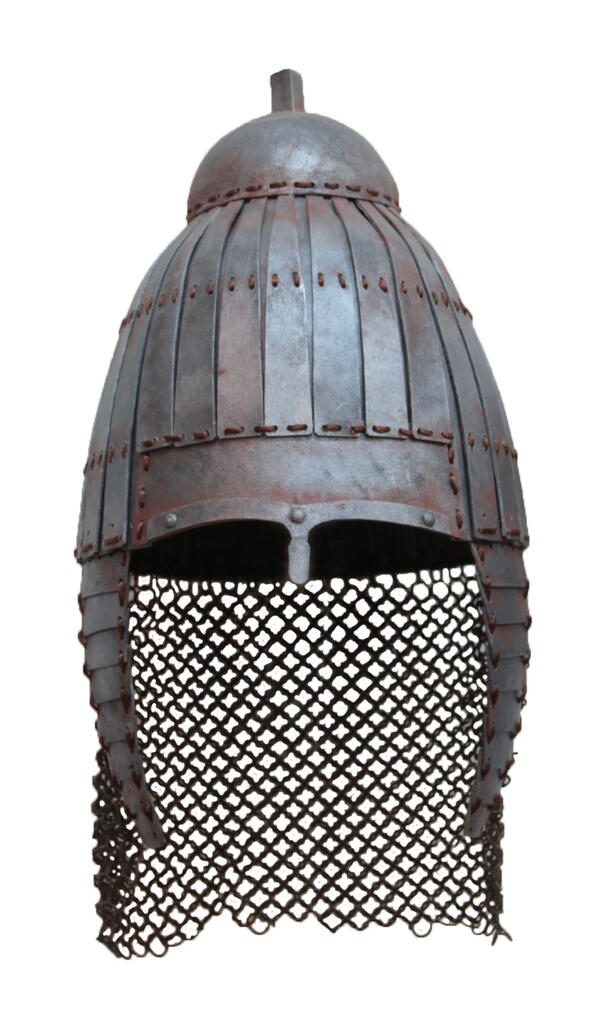The Kursk Regional Museum of Archaeology holds a copy of the helmet, which is dated to the second half of the 5th — the early 6th century. The helmet has a lamellar design, which means that it was assembled from iron plates that were fastened together with leather or thick thread straps. It is possible to single out a number of details: a dome, a forehead plate with a nose-guard, earflaps, a chain mail aventail and an all-metal pommel. After falling to the ground, the combat headpiece lay there until the leather straps holding the plates rotted away, which led to a more compact burial.
The appearance of this type of helmet in Eastern Europe is attributed to nomadic warrior traditions. As of today, there are another four intact helmets consisting of several parts. The earliest finds are from the Far East, the Xianbi burial ground Laoheshen burial ground in China, and are dated from the 3rd to the 5th centuries. A helmet of a similar type was found in an early 5th century burial from Kalkni in Dagestan. Another helmet from Niedersztozingen in Germany is dated to the 6th–7th centuries. In addition, in the early 2000s, a lamellar helmet with armor was discovered in Bulgaria during excavations of a burial site and dated to the beginning of the 7th century.
The story of the helmet was discovered is amazing. In 2010 in Moscow, robbers tried to sell an iron plate helmet with an aventail. The offenders claimed that the military headpiece was found in the Rylsky district of the Kursk region. Thanks to the timely action of law enforcement officers and the help of concerned citizens the helmet was seized and examined. To confirm the location of the find, the members of the Sredne-Seyminskaya expedition of the Institute of Archaeology of the Russian Academy of Sciences contacted the representation of the FSB in the Kursk region and were able to establish who was the first finder of the helmet. It turned out to be a certain Evgeny P., who was engaged in search activities in the Khomutovsky district of the Kursk region. While trying to find items related to World War II, he accidentally discovered the battle helmet in question. He attributed the helmet to the Late Middle Ages and even the New Age and quickly sold the artifact to a dealer he knew. Thus, to date, this helmet is considered an accidental find.
The helmet was transferred to the State Historical Museum in Moscow. The employees of the Kursk Museum of Archaeology took measurements from the original and created a model, which contributed to the exhibition devoted to the history of the population of the Kursk forest-steppe in the 2nd to the 7th centuries AD.
The appearance of this type of helmet in Eastern Europe is attributed to nomadic warrior traditions. As of today, there are another four intact helmets consisting of several parts. The earliest finds are from the Far East, the Xianbi burial ground Laoheshen burial ground in China, and are dated from the 3rd to the 5th centuries. A helmet of a similar type was found in an early 5th century burial from Kalkni in Dagestan. Another helmet from Niedersztozingen in Germany is dated to the 6th–7th centuries. In addition, in the early 2000s, a lamellar helmet with armor was discovered in Bulgaria during excavations of a burial site and dated to the beginning of the 7th century.
The story of the helmet was discovered is amazing. In 2010 in Moscow, robbers tried to sell an iron plate helmet with an aventail. The offenders claimed that the military headpiece was found in the Rylsky district of the Kursk region. Thanks to the timely action of law enforcement officers and the help of concerned citizens the helmet was seized and examined. To confirm the location of the find, the members of the Sredne-Seyminskaya expedition of the Institute of Archaeology of the Russian Academy of Sciences contacted the representation of the FSB in the Kursk region and were able to establish who was the first finder of the helmet. It turned out to be a certain Evgeny P., who was engaged in search activities in the Khomutovsky district of the Kursk region. While trying to find items related to World War II, he accidentally discovered the battle helmet in question. He attributed the helmet to the Late Middle Ages and even the New Age and quickly sold the artifact to a dealer he knew. Thus, to date, this helmet is considered an accidental find.
The helmet was transferred to the State Historical Museum in Moscow. The employees of the Kursk Museum of Archaeology took measurements from the original and created a model, which contributed to the exhibition devoted to the history of the population of the Kursk forest-steppe in the 2nd to the 7th centuries AD.





